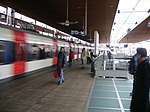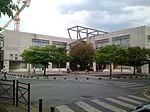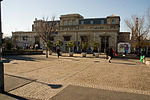Stade de France

The Stade de France (French pronunciation: [stad də fʁɑ̃s], lit. 'Stadium of France') is the national stadium of France, located just north of Paris in the commune of Saint-Denis. Its seating capacity of 80,698 makes it the sixth-largest stadium in Europe. The stadium is used by the France national football team and France rugby union team for international competition. It is the largest in Europe for track and field events, seating 78,338 in that configuration. Despite that, the stadium's running track is mostly hidden under the football pitch. Originally built for the 1998 FIFA World Cup, the stadium's name was recommended by Michel Platini, head of the organising committee. On 12 July 1998, France defeated Brazil 3–0 in the 1998 FIFA World Cup Final contested at the stadium. It will host the athletics events at the 2024 Summer Olympics. It will also host matches for the 2023 Rugby World Cup. After the 2022 Russian invasion of Ukraine, it was announced that the 2022 UEFA Champions League Final would be moved from the Gazprom Arena to the Stade de France. The Stade de France, listed as a Category 4 stadium by UEFA, hosted matches at the 1998 FIFA World Cup, the UEFA Champions League finals in 2000, 2006 and 2022. As well as the 1999 and 2007 Rugby World Cup, making it one of only two stadia in the world to have hosted both a Football World Cup final and a rugby union World Cup final (along with Nissan Stadium in Yokohama). It also hosted seven matches at UEFA Euro 2016, including the final, where France lost to Portugal 1-0 after extra-time. The facility also hosted the Race of Champions auto race in 2004, 2005, and 2006. The stadium hosted the 2003 World Championships in Athletics and from 1999 to 2016 it hosted the annual Meeting Areva athletics meet. Domestically, the Stade de France serves as a secondary home facility of Parisian rugby clubs Stade Français and Racing 92, hosting a few of their regular-season fixtures. The stadium also hosts the main French domestic cup finals, which include the Coupe de France (both football and rugby), Coupe de la Ligue, Challenge de France, and the Coupe Gambardella, as well as the Top 14 rugby union championship match. The facility is owned and operated by the Consortium Stade de France.
Excerpt from the Wikipedia article Stade de France (License: CC BY-SA 3.0, Authors, Images).Stade de France
Avenue du Président Wilson, Saint-Denis La Plaine
Geographical coordinates (GPS) Address Nearby Places Show on map
Geographical coordinates (GPS)
| Latitude | Longitude |
|---|---|
| N 48.924438055556 ° | E 2.3601038888889 ° |
Address
Stade de France
Avenue du Président Wilson
Saint-Denis, La Plaine
Ile-de-France, France
Open on Google Maps









